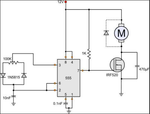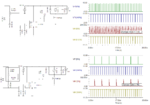gauravkothari23
Advanced Member level 2
Hi All, I am designed a small 12V 1Amps DC Motor Speed Controller using NE-555 IC
(Circuit Diagram attached).
My question is when i drive the motor at maximum i get 12v but the lowest voltage what i get is 2.50V. but i need 0V at minimum. what changes have to be made to pull down the voltage to 0V at minimum.
(Circuit Diagram attached).
My question is when i drive the motor at maximum i get 12v but the lowest voltage what i get is 2.50V. but i need 0V at minimum. what changes have to be made to pull down the voltage to 0V at minimum.


